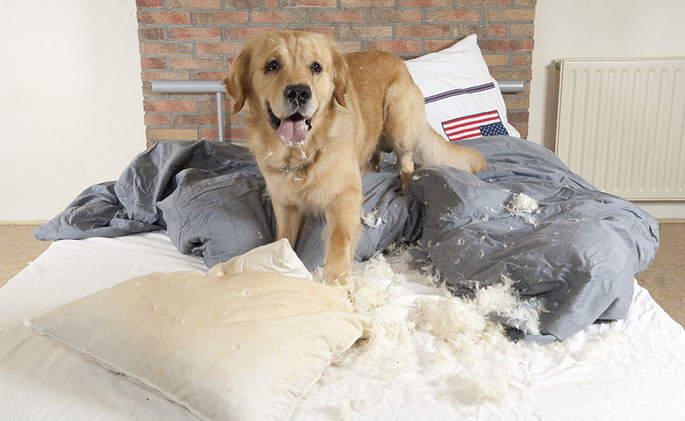
Pets bring immense joy and companionship into our lives, but sometimes, their behavior can lead to the destruction of our homes. Whether it’s chewing, scratching, or digging, these actions can be frustrating and costly. Fortunately, there are effective strategies to curb destructive behavior and maintain a harmonious home environment. Here’s how to stop your pets from destroying your house.
Understanding the Cause
Before you can effectively address the issue, it’s crucial to understand why your pet is engaging in destructive behavior. Common reasons include:
- Boredom and Lack of Stimulation: Pets, especially dogs and cats, need mental and physical stimulation. Without it, they may turn to destructive behaviors to entertain themselves.
- Separation Anxiety: Pets can become anxious when left alone for long periods, leading to destructive behavior as a way to cope with their stress.
- Teething: Puppies and kittens chew to relieve the discomfort of teething.
- Attention-Seeking: Sometimes pets act out to get your attention, even if it’s negative.
- Territorial Marking: Cats and dogs may scratch or chew to mark their territory.
Strategies to Prevent Destructive Behavior
1. Provide Adequate Exercise and Mental Stimulation
Ensuring your pet gets enough physical exercise and mental stimulation is key to preventing boredom-induced destruction.
- Daily Walks and Playtime: Regular walks, play sessions, and interactive toys can help burn off excess energy.
- Puzzle Toys and Treat Dispensers: These can keep your pet occupied and mentally engaged.
- Training and Obedience Classes: Teaching your pet new commands or tricks can be a great way to stimulate their mind.
2. Create a Safe and Engaging Environment
Make your home a place where your pet can feel secure and entertained.
- Designate a Pet-Friendly Space: Create a safe area with their bed, toys, and water where they can retreat and relax.
- Scratching Posts and Chew Toys: Provide appropriate items for your pets to scratch or chew on instead of your furniture.
3. Address Separation Anxiety
Separation anxiety can be a significant trigger for destructive behavior.
- Gradual Desensitization: Gradually increase the time you spend away from your pet to help them get used to being alone.
- Comfort Items: Leave behind a piece of clothing that smells like you to provide comfort.
- Interactive Cameras and Treat Dispensers: These allow you to check in on your pet and dispense treats remotely, providing reassurance.
4. Use Deterrents
Sometimes, using deterrents can discourage your pet from engaging in destructive behavior.
- Bitter Sprays: Apply these to furniture or other items your pet likes to chew on.
- Noise-Making Devices: Use devices that emit a sound when your pet engages in unwanted behavior, such as scratching or chewing.
5. Positive Reinforcement
Reward good behavior to encourage your pet to repeat it.
- Treats and Praise: Whenever your pet chooses to use their toys instead of your furniture, reward them with treats and praise.
- Consistent Training: Be consistent with your training and reinforcement to help your pet understand what behaviors are acceptable.
6. Regular Veterinary Check-Ups
Sometimes, destructive behavior can be linked to underlying health issues.
- Check for Medical Problems: Regular vet visits can help identify any medical conditions that might be causing your pet’s behavior.
- Discuss Behavior Issues: Your vet can provide advice or refer you to a pet behaviorist if needed.
How to Keep Dogs Off Your Property
Keeping dogs off your property can be a challenge, especially if you live in an area with many roaming pets or if you have issues with stray dogs. Here are effective strategies to deter dogs and protect your property without causing harm to the animals.
1. Secure Your Perimeter
The first line of defense is ensuring your property is well-secured.
- Fencing: Install a sturdy fence around your property. A solid, tall fence (at least 6 feet) can prevent dogs from jumping over or digging under.
- Gate Maintenance: Ensure gates are always closed and in good condition. Use locks if necessary to prevent dogs from pushing them open.
- Anti-Digging Measures: Bury chicken wire or hardware cloth at the base of your fence to prevent dogs from digging under it.
2. Use Natural Deterrents
Dogs have sensitive noses, and certain scents can deter them from entering your property.
- Citrus: Scatter citrus peels (such as lemon or orange) around the perimeter. Dogs generally dislike the strong smell of citrus.
- Vinegar: Spraying vinegar along the boundary can also deter dogs due to its strong odor.
- Coffee Grounds: Sprinkle used coffee grounds around the yard. They not only deter dogs but also enrich the soil.
3. Commercial Repellents
There are several products available designed to keep dogs away.
- Repellent Sprays: These sprays are available in pet stores and can be applied around your yard to create an invisible barrier.
- Granules: Similar to sprays, repellent granules can be scattered around the perimeter of your property.
4. Create Physical Barriers
In addition to fencing, other physical barriers can help keep dogs off your property.
- Landscaping: Plant dense shrubs or thorny plants along your fence line. These can act as a natural barrier that dogs are reluctant to pass through.
- Gravel: Use gravel or large stones in areas where dogs might try to dig. Dogs usually find these surfaces uncomfortable to walk or dig on.
5. Ultrasonic Devices
Ultrasonic devices emit a high-pitched sound that is unpleasant to dogs but usually inaudible to humans.
- Motion-Activated Ultrasonic Devices: Place these devices around your property. When a dog comes near, the device will activate, emitting a sound that will deter the dog.
6. Water Sprayers
Motion-activated water sprayers can be an effective and humane deterrent.
- Sprinklers: Set up motion-activated sprinklers in your yard. When a dog enters the area, the sprinkler will turn on, spraying water and scaring the dog away.
7. Training and Education
If the problem dogs belong to neighbors, having a conversation can be beneficial.
- Discuss with Neighbors: Politely inform your neighbors about the issue and request that they keep their dogs contained.
- Community Efforts: Work with your community to address stray dog problems. This might include contacting animal control or setting up community meetings to discuss solutions.
8. Safe Zones and Diversions
Create areas or distractions that draw dogs away from your main property.
- Designated Dog Area: If feasible, create a designated dog-friendly area away from your main garden or yard. This can include a patch with dog-friendly plants and toys.
- Bait and Distract: Use dog toys or treats to lure dogs away from critical areas. Over time, they may learn to stay in these designated spots.
Conclusion
Stopping your pets from destroying your house requires understanding the root cause of their behavior and addressing it through a combination of exercise, mental stimulation, environmental enrichment, and training. By creating a safe and engaging environment and using positive reinforcement, you can help your pet develop good habits and reduce destructive behaviors. Remember, patience and consistency are key. With time and effort, you can enjoy a harmonious home with your beloved pets.



